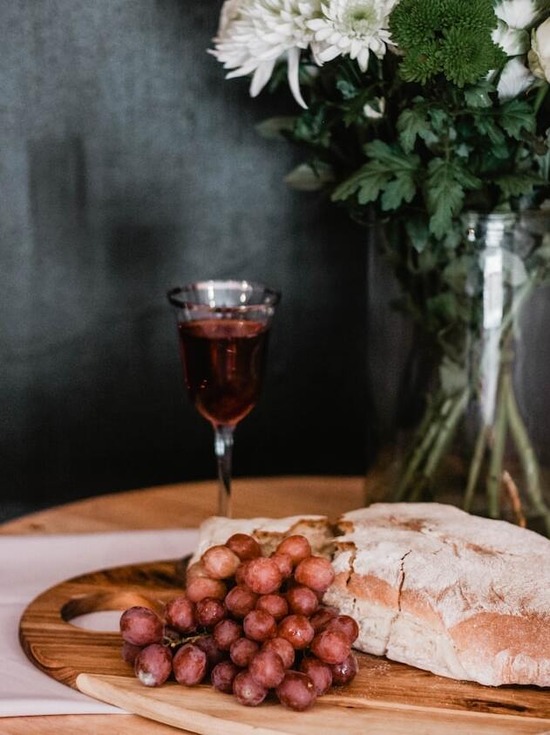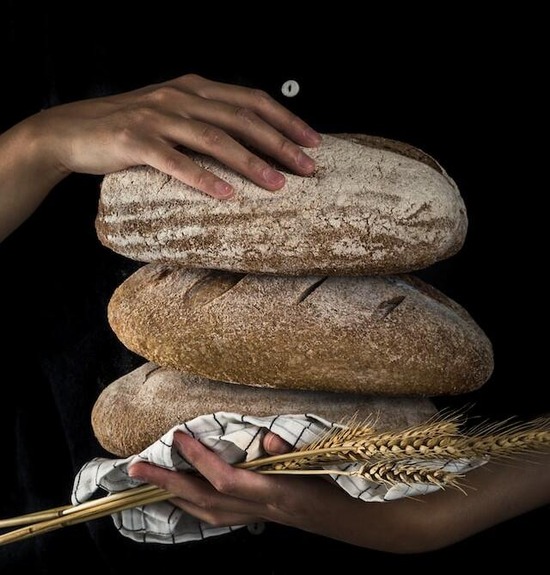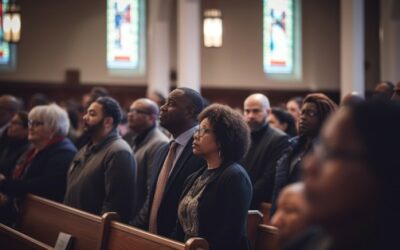Like many Christian denominations, Adventists regularly participate in communion, also referred to as the “Lord’s Supper” or the “Last Supper.” They also practice foot washing (John 13:1-20), or the “ordinance of humility,” during the service—which isn’t as common.
Adventists worship services don’t typically include communion every Sabbath. But it’s also not solely reserved only for certain time of year, such as Maundy Thursday or Easter. Instead, most Adventist churches celebrate communion once per quarter, or every three months.
But what exactly does this communion service involve? And does it follow what the Bible says about what it should be like?
We’re about to answer:
- Where the idea of communion comes from
- What Adventist communion services are like
- Why Adventists have a foot washing service (and what they’re like!)
- Why Adventists celebrate communion
First, let’s get some background information from the Bible.
Where does the idea of Communion come from?
The idea of communion comes directly from the Gospels in the New Testament of the Bible. Commonly referred to as the Lord’s Supper or the Last Supper, it commemorates the meal Jesus shared with His disciples before being crucified.
This meal is described in each of the Gospels in the following passages: Matthew 26:26-30, Mark 14:22-26, Luke 22:14-30, and John 13:1-30. Each of these accounts explains that the Lord’s Supper happened on the same day as another ceremonial meal—the Passover.
This Jewish ceremony celebrates how God delivered the Hebrews—the Jews’ ancestors—from slavery (Exodus 12:24-27). This traditional meal called for specific foods like unleavened bread and lamb served with bitter herbs (Exodus 12:14-20). Many of these foods had symbolic meanings. They served lamb to represent the lamb that was sacrificed to protect the Hebrews from God’s plague on the Egyptians (Exodus 12: 24). They served unleavened bread to symbolize how the Hebrews didn’t have much time to let the bread rise before fleeing Egypt (Exodus 12:11).
As Jews, Jesus and His disciples were sure to participate in this traditional dinner. They met in the upper room of a house to eat it together.
It was the same Passover meal they’d had plenty of times before.
Until Jesus decided to do something new:
“When the hour came, Jesus and His apostles reclined at the table. And He said to them, ‘I have eagerly desired to eat this Passover with you before I suffer. For I tell you, I will not eat it again until it finds fulfillment in the kingdom of God.’
After taking the cup, He gave thanks and said, ‘Take this and divide it among you. For I tell you I will not drink again from the fruit of the vine until the kingdom of God comes.’
And He took bread, gave thanks and broke it, and gave it to them, saying, ‘This is My body given for you; do this in remembrance of Me.’
In the same way, after the supper He took the cup, saying, ‘This cup is the new covenant in My blood, which is poured out for you’” (Luke 22:14-20, NKJV).
Jesus knew He was about to die. He knew how the Jewish leaders were plotting to convince the Romans to crucify and beat Him like a criminal of the state. He knew He would be sentenced to death as an innocent man, for the sake of humanity’s sin.
He was facing an unimaginable amount of pressure—but still, Jesus wanted His disciples to understand what He was doing for them. So He related His soon death by comparing it to the Passover bread and wine. And with these symbols, He painted a picture of loving, selfless sacrifice.
Of course, it was no coincidence that the Passover was also all about sacrifice.
While the Israelites were in Egypt and the plagues were happening to the Egyptians, God gave instructions for escaping the final plague against the firstborn. God told the Hebrews to sacrifice a lamb and place its blood on their doorposts.
And even after they left Egypt, God continued to use the lamb as a symbol of salvation.
Looking back at the time of the Israelites’ journey through Egypt, God knew He was working with a group of newly-freed slaves who were largely uneducated. So He set up a symbolic sacrificial system for them to fully understand the idea of a holy and innocent Savior (Jesus Christ, or the Messiah) being a substitute for our sins’ penalty, which in turn allows us to be reconciled to God.
This symbolic process involved sacrificing a gentle, innocent lamb to pay the price for going astray from God. Doing this uncomfortable and unpleasant act would allow them to gain forgiveness for their sins.
These ceremonies prepared the Hebrews to fully understand the cost of sin—and the ultimate length God was willing to go to save them from it.
Both the Passover lamb and the sacrificial lamb pointed toward the same thing. They were foreshadowing the soon sacrifice of Jesus, the “Lamb of God” (John 1: 29).
And since the whole purpose of these ceremonies was to prepare the Hebrews for the sacrifice of Christ, they had no need for these practices when He died.
In other words, we no longer needed a symbol of Jesus’ sacrifice now that we have the story of the crucifixion of Christ. We can fully appreciate and accept the real thing.
That’s why, in Passover’s place, God created a new ceremony—one that wouldn’t only point forward to Jesus’ sacrifice, but point backward to how He accomplished this on the cross.
(Though it also points forward to the second coming of christ…since Jesus told His disciples that He “will not drink from this fruit of the vine from now on until that day when I drink it new with you in My Father’s kingdom” [Matthew 26:29, CSB].)
What are Adventist Communion services like?

Photo by Sincerely Media on Unsplash
Adventist Communion services are similar to that of other Protestant churches. The only major difference is that we observe the foot washing service Jesus speaks of in John 13:8-11.
The word communion means “an act of sharing” or “an intimate relationship with deep understanding.”1 And that’s exactly the way Adventists think of it. It’s a time to come together with fellow believers and remember what Jesus did for us.
And by fellow believers, we mean anyone who professes Christ as their savior.
That’s right—our Communion service isn’t restricted to Adventists. Anyone who wishes to celebrate what Jesus did for us is welcome to join in, church member or not.
So if you walk into an Adventist Church on a Communion Sabbath, the worship service will likely begin as usual. Though you may see that up front, there’s a table with stacked trays of Communion bread.
Communion Sabbath typically happens every three months. There’s no special reason for its timing. We just want it to happen often enough to refresh our minds of Jesus’s sacrifice, but not so often that it becomes a mindless ritual.
Of course, Communion services can vary from congregation to congregation. But the one element all Adventist services have in common is the use of the “emblems”—sharing the unleavened bread and the “fruit of the vine,” or grape juice.
We have special containers reserved for the Communion service. The small grape juice glasses are placed in a special container with slots for the small cups of juice, rather than drinking from a communal cup. The pieces of bread are placed on a matching plate, usually covered with a cloth before serving.
Now, when we say bread, we don’t mean a fluffy loaf of brioche or rye.
The bread Jesus ate was unleavened per Passover specifications (Deuteronomy 16:3). For this reason, the bread at our Communion is also unleavened. A member of the church, or deacons or deaconesses, will often volunteer to make the bread using a combination of flour, salt, and water. The result is a soft, cracker-shaped bread similar to a graham cracker. And it still tastes pretty good.
Instead of using fermented wine, we use grape juice. This is mainly for practicality and health reasons. Though, in general, most Adventists avoid alcohol.
One last note to make is that Adventists believe the bread and grape juice are only symbols of Jesus’ body and blood—not His actual flesh. As a church, we don’t believe in transubstantiation, which teaches that a priest can say a prayer of consecration that transforms the bread and wine into the literal body and blood of Christ.2
But whatever you believe about the nature of the bread and juice, the whole idea behind all of this is that we remember why we’re celebrating this ritual—because Jesus Christ loves us so much that He was willing to have His body beaten and broken for us, and willing to have His blood spilled (to die) so that we won’t have to be forever separated from God.
The order of service
The church service might start with announcements, greeting one another, special music, Scripture readings, prayer, etc. Then it’ll transition into the “Last Supper” part of the service.
The “ordinance of humility,” or foot washing, might take place before or after the homily and the sharing of emblems. The worship leaders will provide instructions for where you’ll go to begin the foot washing.
The pastor or elders will introduce the Communion part of the service and this usually includes a reading of one of the passages from the Gospels that describes the very first Communion. Then they’ll pray over the bread and juice.
Next, elders or deacons will take the trays around to the congregation, making sure everyone wanting to participate gets a piece of bread and a small cup of juice.
But the congregation doesn’t eat the bread right away. We’ll wait until the pastor’s signal, so we can all do it together in remembrance.
Often, this “signal” is reading the verses from the Gospels—the first for eating the bread, the second for drinking the juice.
“And He took bread, gave thanks and broke it, and gave it to them, saying, ‘This is My body which is given for you; do this in remembrance of Me’” (Luke 22:19, NKJV).
“Then He took the cup, and gave thanks, and gave it to them, saying ‘Drink from it, all of you. For this is My blood of the new covenant, which is shed for many for the remission of sins’” (Matthew 26:27-28, NKJV).
After this, there might be a moment of silence, some singing, a few more words from the pastor, or it may be time for some churches to dismiss for foot washing.
Our intentions in upholding this ceremony is to fulfill Jesus’ call to “do this in remembrance of Me” (Luke 22:19, NKJV).
And it also reflects how in all things, the Seventh-day Adventist Church aims to follow the guidance and framework we find in the Bible. And that includes following Jesus’ lead in practicing foot washing along with Communion.
Why Adventists have a foot washing service (and what they’re like!)
Adventists practice foot washing because Jesus asks Christians to wash one another’s feet (John 13:14). Yes, it can be awkward and a little more intimate than most social interactions we’re used to, but that’s also why it’s referred to as the “ordinance of humility.” We are reminded that we’re here to serve one another.
The Gospel of John describes the account of Jesus washing the disciples’ feet. And it’s interesting how the disciples, namely Peter, react:
“Peter said to Him, ‘You shall never wash my feet!’ Jesus answered him, ‘If I do not wash you, you have no part with Me.’ Simon Peter said to Him, ‘Lord, not my feet only, but also my hands and my head!’ Jesus said to him, ‘He who is bathed needs only to wash his feet…” (John 13: 8-10, NKJV).
The washing of feet was actually common during those times, so Peter wasn’t reacting at the idea of washing feet. What he was riled up about was that Jesus would lower Himself to do such a subservient act.
Most of the time, a servant was assigned to wash the feet of their masters. And with all the walking on dirt paths in sandal-wearing feet, you can imagine that this wasn’t a pleasant task.
Add to this that the disciples were still caught up in the idea of being significant in the kingdom of God. And yet this man washing their feet was whom Peter confessed was indeed “the Christ, the Son of the living God” (Matthew 16:16, NKJV). So he felt that such a lowly act shouldn’t be something that Jesus, their master and teacher, should be doing for them, who merely follow Him!
But that’s exactly why Jesus did this. He was intentionally showing a servant-leadership attitude toward His beloved followers. He showed them that being a Christian is not all about holiness or piety…it’s about being willing to get down in the dirt in order to serve someone.
Jesus defied ranks and roles, showing how everyone should treat everyone else.
That’s why we feel it’s important to do the same in our Communion services.
And here’s what it’ll probably be like at a typical Adventist Communion service:
When it’s time for foot washing, the congregation will leave the sanctuary and split into groups. Most of the time, women go to one area and men to another. There’s often an area for families, too. This is mainly to ensure that everyone who participates feels comfortable and appropriate.
These groups will go into different rooms where deacons and deaconesses (members of the church responsible for helping out with the church service) will have prepared towels and bowls of warm water. People will pair up and wash each other’s feet.
The foot washing doesn’t involve any scrubbing or soap. The feet will just be submerged and gently splashed with water.
After washing a person’s feet, they’ll use the towel to dry them off. Then the partners will switch.
After you and your partner’s feet are cleaned, you will have the opportunity to pray together. This will give you the chance to form a deeper connection with those in your faith community.
But even though there are so many benefits to this, the ordinance of humility is not required. No part of any church service is. So if you’re new and just not quite ready for this, it’s ok to opt out and stay in the sanctuary. You can take this time to pray, reflect, or read more about the Communion stories in the Gospels.
But you can be assured that foot washing doesn’t have to be awkward or burdensome. In fact, it blesses the congregation in a variety of ways. When we wash others’ feet we are reminded to humbly serve others. And when we accept the washing from someone else we are reminded of Jesus’ promise to cleanse our lives of sin and our fellow believers’ role in encouraging us to follow Jesus.
Why Adventists practice Communion

Photo by David Weber on Unsplash
First and foremost, it’s because of Jesus’ command to remember His sacrifice through the Lord’s Supper. He tells us to eat the bread and drink the grape juice in remembrance of Him.
It’s a way for us to regularly remember and reflect on the sacrifice Jesus made for us. And as busy as we get, sometimes we need a reminder. Sometimes we forget the magnitude of the price Jesus paid for us. Life can be so full of spiritual distractions.
But when we remember it, we can be humbled by the wonderful gift of grace. We remember that when we accept His sacrifice, we accept His love—and become a new person, continually being sanctified by the Holy Spirit.
And Jesus had a very particular way of reminding us of this. He didn’t tell us just to think or pray about His sacrifice every so often—He had us remember it through a meal. He chose to help us remember by comparing His body and blood to sustenance.
Think of it this way: when you’re eating something, you absorb it into your body. In a way, it becomes a part of you. It helps sustain you. In the same way, when you accept Jesus’ sacrifice, it should have an impact on your entire life—the way you live, the way you treat others, and the way you think of God.
It’s not just a matter of passively accepting the gospel, but learning to actively include the gospel in your everyday life. And just like the humble service of foot washing, Communion is yet another way of inviting the Holy Spirit to help you be more like Jesus.
We see the foot washing service as an extension of Communion, as it provides yet another reminder of the spirit of Christianity—loving others as Christ has loved us.
We think of this time as an opportunity to recommit our lives to Jesus and remember what He did for us. You might notice an especially reverent tone in an Adventist Church when Communion is being held. After all, thinking about the death of our Savior is a somber subject. But even considering the heavy cost of sin and the price Jesus paid to deliver us, we find hope.
Jesus’ gift of reconciliation with God, and eternal life with Him, isn’t something we take lightly. The cost of sin is great, but the price God paid for us is even greater. So we can use Communion as a time of deep gratitude, and to enjoy the fellowship of those who share this gratefulness toward our Creator and Savior.
Want to learn more about Adventist church services in general? Take a look at
Ready to attend a Communion service? Find an Adventist Church close to you and find out when the next Communion is scheduled on the calendar.
Related Articles
More Answers
Do Adventists Celebrate Christmas?
In many parts of the world, Seventh-day Adventists celebrate Christmas as a way to remember the birth of Christ. In certain parts of Africa, though, Christmas is much more low-key for Adventists, having less to do with religion and more to do with family time.
What Is ASI (Adventist-Laymen’s Services and Industries)?
ASI, which stands for Adventist-laymen’s Services and Industries, is a membership-based organization that provides support for Seventh-day Adventist laypeople (Adventist professionals who aren’t pastors).
Sola Scriptura—What Does It Mean, and Why Is It So Important?
Sola scriptura is a term that originated during the Protestant Reformation. It represents the way many Christians view the Bible and its authority.
What is the Concept of “Present Truth” and Why is it Important?
Present truth is the principle that certain biblical truths are relevant to God’s people at specific times in history. God sends the Holy Spirit to reveal truths that help us better understand how to interpret and apply His Word in a present moment.
What Does the Bible Say About Modesty
The Bible teaches that modesty, a form of humility and respect, is a valuable quality in everyone—men, women and children. It has to do with how we present ourselves, which should exemplify our inner relationship with God.
13th Sabbath Offering: What It Is and Why It Matters
On the last Sabbath of every quarter, Adventist churches participate in the 13th Sabbath offering—a special offering that goes to mission fields around the world.
Adventist Movies: Where Faith and Film Meet
The Seventh-day Adventist Church’s mission from the beginning has been to share God’s truth in the Bible. And as times have changed, we’ve explored new ways of doing this—one of those being movies.
Everything You Need to Know About an Adventist Church Potluck
Every so often, usually on a schedule ranging from once a week to once a month to once a quarter, an Adventist church will have “fellowship dinners,” often casually referred to as potlucks.
How to Join the Seventh-day Adventist Church
Whether you heard about the Seventh-day Adventist Church through a traveling evangelist, during your online searches, or through a loved one or relative, you might be considering joining yourself.
How Do Adventists Make Movie and Music Choices?
We have entertainment at our fingertips. With just a tap on our smartphones, we can access all the latest movies, music, YouTube videos, and more.
Do Adventists Celebrate Birthdays?
Yes, most Seventh-day Adventists do celebrate birthdays because we see them as excellent reminders of the life God has blessed us with. And we celebrate them the same way everyone else does—with friends, family, presents, and a special meal.
Are Seventh-day Adventists Christians?
Yes, the Seventh-day Adventist Church is a Protestant Christian denomination formed in 1863. Just like other Christians, we believe that Jesus Christ is our Savior and seek to follow the principles of the Word of God.
Do Seventh-day Adventists Believe in the Secret Rapture
The secret rapture belief asserts that the followers of Jesus will be suddenly and stealthily “raptured” from earth and taken to heaven. Then, any people left on earth will face a period of great difficulty—before Christ’s second coming actually happens.
The Seventh-day Adventist Hymnal
The Seventh-day Adventist Hymnal is a songbook used worldwide by many Adventist congregations during their worship services. Since its publication in 1985, it has helped foster praise to God while reminding church members of our mission and drawing them closer to Jesus.
Do Adventists Have Their Own Bible?
Adventists have some unique beliefs—you might be able to name some of them right now. The seventh-day Sabbath. Death as a sleep. Hell as nonexistence.
How do Adventists choose what to eat?
Every day, parents go through the ritual of getting their kids to eat what is healthy and good while trying to steer them away from what can hinder the growth of their developing bodies. Nutritionists work with their clients to make better food choices.
What Are Seventh-Day Adventist Sermons Like?
In nearly every Seventh-day Adventist Church, the sermon is the focal point of the main service—similar to many Protestant Christian denominations. It is a time of biblical instruction by the pastor, who shares what they’ve been studying in the Bible and preparing over the previous week.
Didn’t find your answer? Ask us!
We understand your concern of having questions but not knowing who to ask—we’ve felt it ourselves. When you’re ready to learn more about Adventists, send us a question! We know a thing or two about Adventists.




















